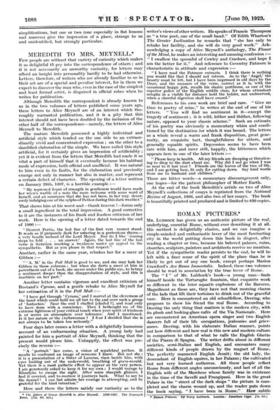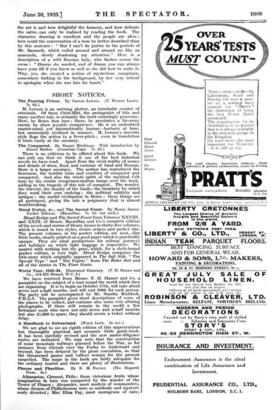ROMAN PICTURES.*
Mn. LUBBOCK has given us an authentic picture of the real, underlying, essential Rome, without ever describing it at all. His method is delightfully elusive, and we can imagine a simple-minded and enthusiastic lover of the most fascinating city in the world putting down this book in disgust, after reading a chapter or two, because his beloved palaces, ruins, churches, sculptors, painters and architects receive no mention. Yet if the sympathetic reader persists to the end, he will be left with a finer sense of the spirit of the place than he is likely to get out of any one book, except perhaps Marion Crawford's Ave Roma Immortalis. Indeed, these two volumes should be read in association by the true lover of Rome.
The " I " of Mr. Lubbock's book—a young man—finds himself beside the Tartarughe fountain, that exquisite work so different to the later aquatic explosions of the Barocco. Magnificent as these are, they have not that morning charm of the lads that lift their tortoises to drink out of the graceful vase. Here is encountered an old schoolfellow, Deering, who proposes to show his friend the real Rome. According to Deering the only thing that matters is the modern city, with its plush and looking-glass cafes of the Via Nationale. Here are encountered an American opera singer and two English dancers full of their life occupations, jealousies and griev- ances. Deering, with his elaborate Italian manner, points out how different and how real is this new and modern culture in comparison to that of what he calls the English Ghetto of the Piazza di Spagna. The writer drifts about in different societies, semi-Italian and English, and encounters many different kinds of people drawn by the magnet of Rome. The perfectly mannered English Jesuit; the old lady, the descendant of English squires, in her Palazzo ; the cultivated but not very learned authoress. All these people reflect Rome from different angles unconsciously, and last of all the English wife of the Marchese whose family was in existence in the time of the Savelli and Frangipani. Here in the great Palace in the " street of the dark shops " the picture is com- pleted and the charm wound up, and the reader puts down the book saying, " I have been in _Rome." How subtle.
• 'Roman Pfeturea:- Bf Percy Lubbock. LondOu: Jonathan Cape. 17s. 68.1
the art is and how delightful the humour, and how delicate the satire, can only be realized by reading the book. The character drawing is excellent and the people are alive ; how could the conversation of a bore be better described than by this sentence : " But I can't do justice to the periods of Mr. Bannock, which coiled around and around me like an anaconda, slowly deadening my attention." Here is a description of a wild Russian lady, who flashes across the scene : " Drama she needed, and of drama you can always have your fill if you know as well as she did how to make it. Why, yes, she created a notion of mysterious conspiracy, somewhere lurking in the background, by her very refusal to apologize when she was late for lunch."











































 Previous page
Previous page